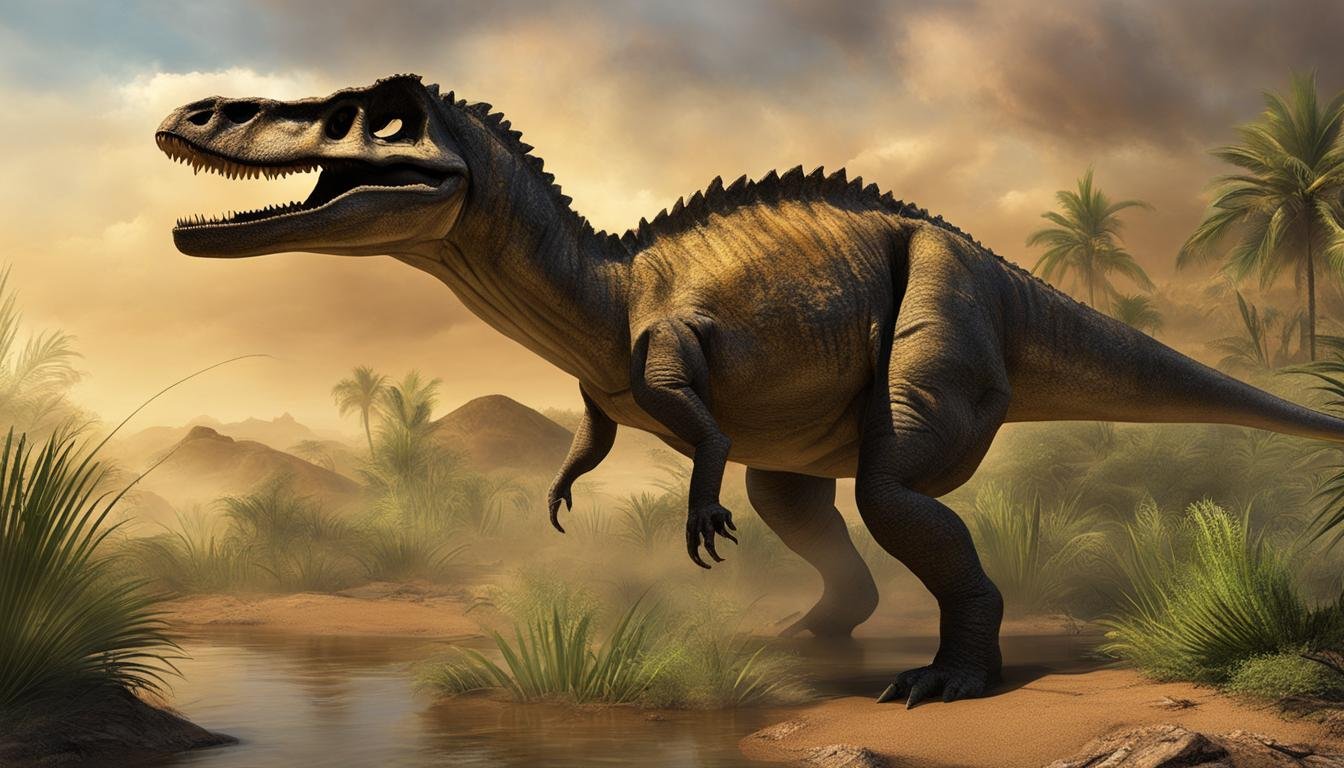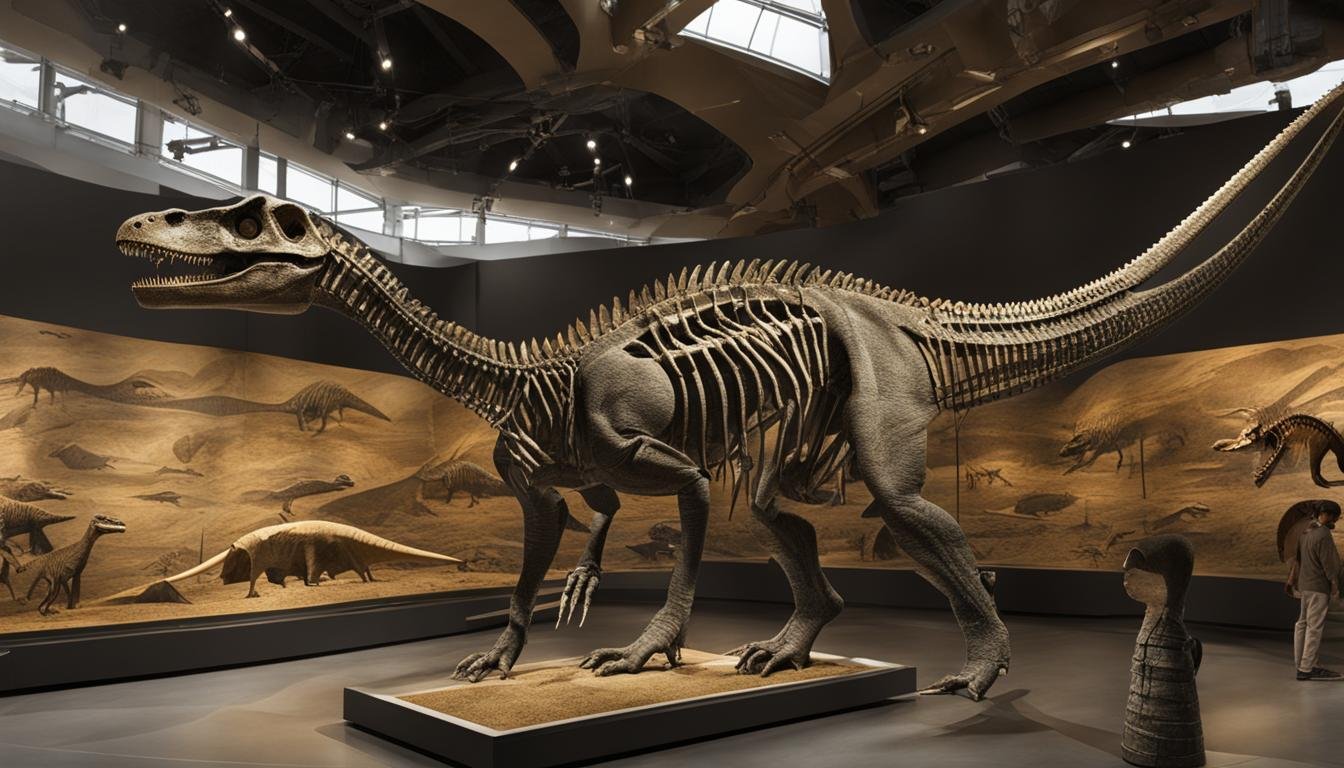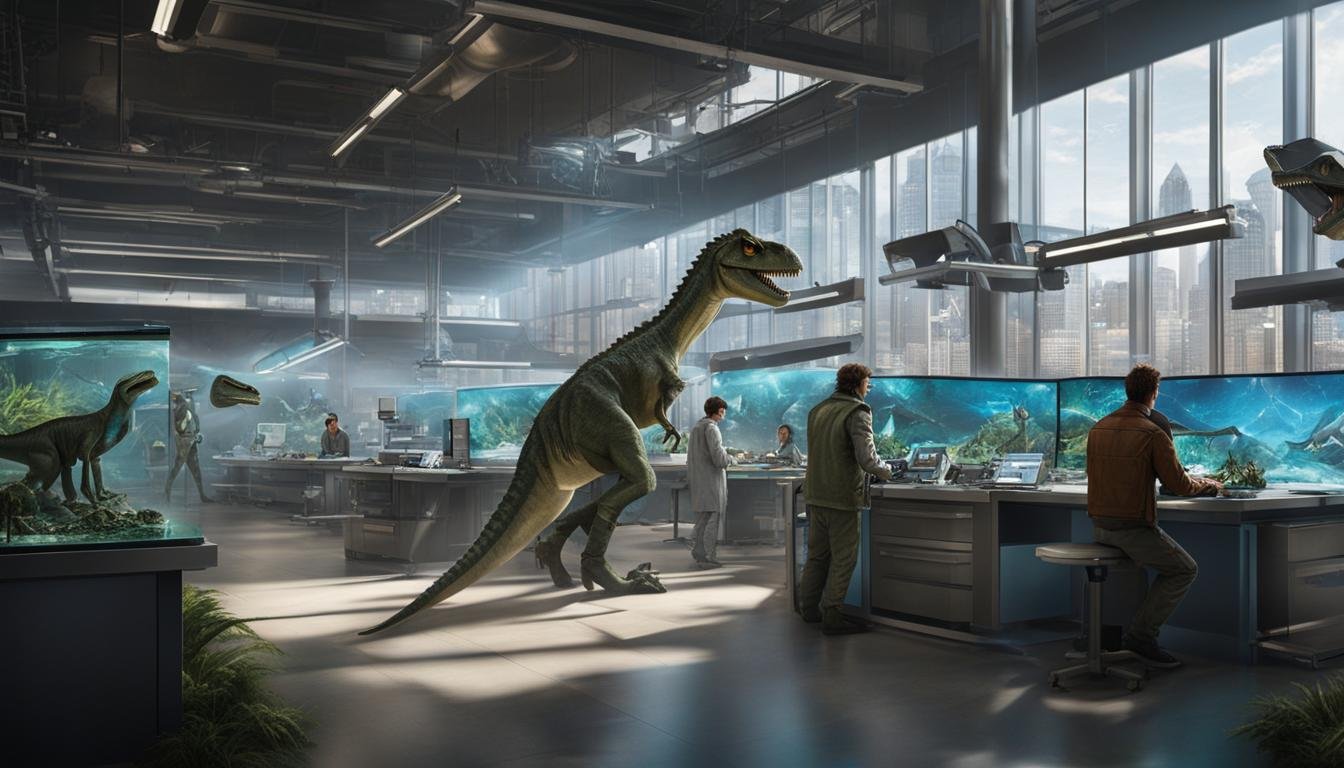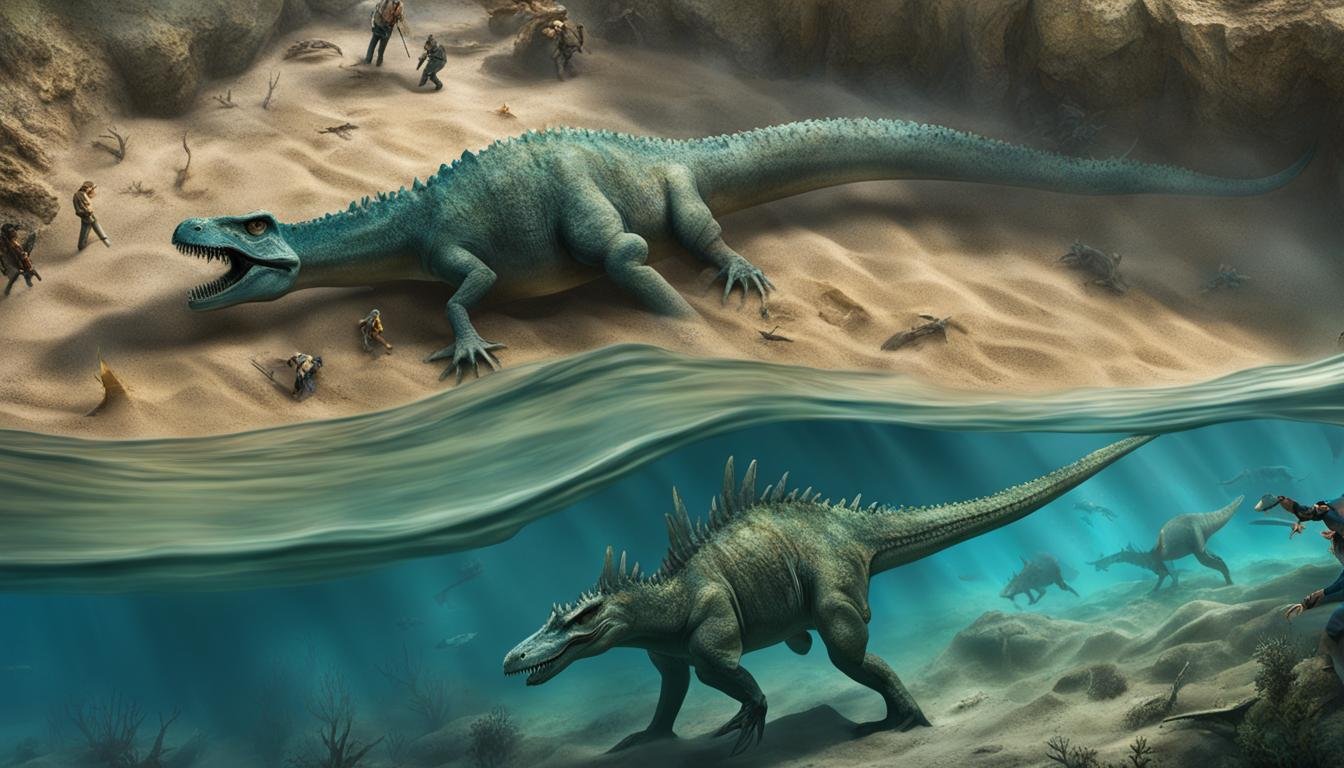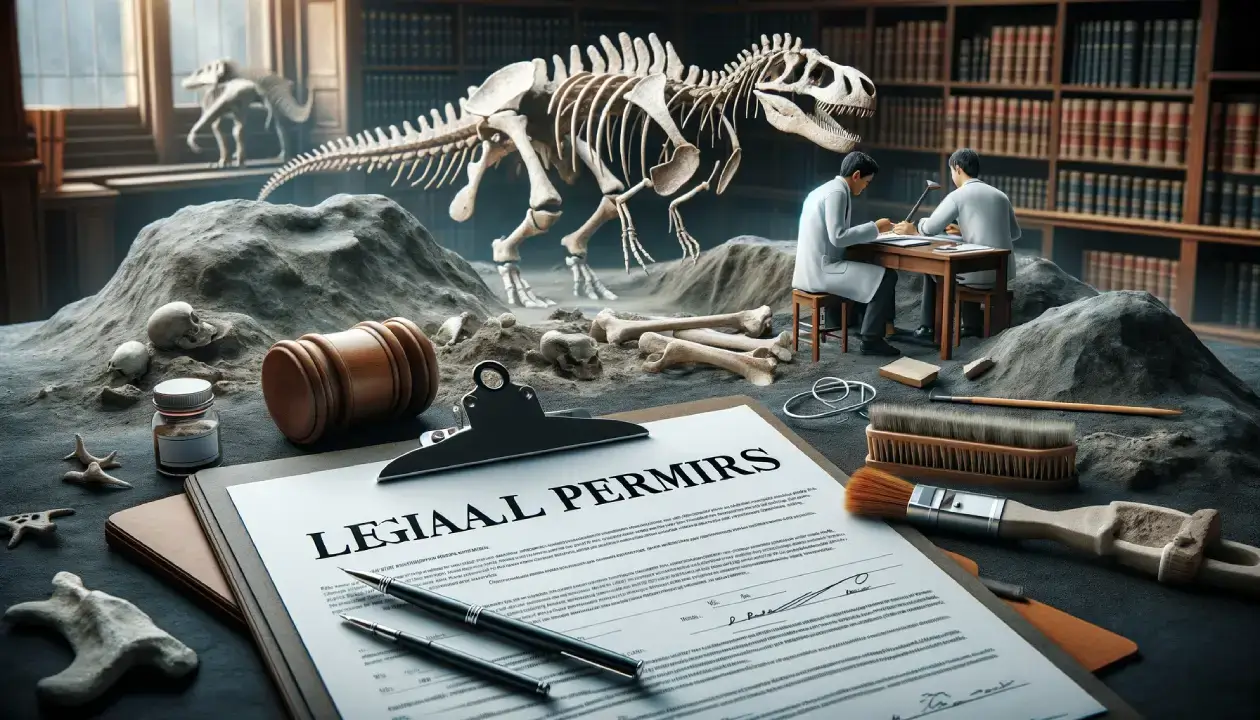Climate change has long been a topic of debate when it comes to understanding the extinction of non-avian dinosaurs. While the Chicxulub asteroid impact is often blamed, recent studies suggest that climate played a significant role in shaping the fate of these ancient creatures.
During the Late Cretaceous period, dinosaurs demonstrated remarkable adaptability and resilience in the face of environmental changes and climatic fluctuations. However, limitations in fossil preservation have led to an underestimation of dinosaur species diversity at that time.
| Key Points | Takeaways |
|---|---|
| Climate’s Role in Dinosaur Extinction | Climate change, along with asteroid impact, played a significant role in the extinction of non-avian dinosaurs. |
| Fossilization and Climate | Environmental conditions greatly influenced dinosaur fossil preservation, with regional variations affecting species diversity estimates. |
| Taphonomy and Paleoecology | Understanding fossilization processes (taphonomy) is crucial for deciphering ancient ecosystems and dinosaur behavior. |
| Climate Change and Marine Fossils | Rising global temperatures enhanced the preservation of soft tissues in marine fossils, offering unique insights into ancient ecosystems. |
| CO2 Levels and Dinosaur Migration | Fluctuations in carbon dioxide levels significantly influenced dinosaur migration patterns, particularly for sauropodomorphs. |
| Greenland’s Dinosaur Fossils | The discovery of sauropod fossils in Greenland suggests suitable past climate conditions for their migration and settlement. |
| Climate Change as a Fossilization Catalyst | Rapid climate changes impacted sediment availability, affecting fossil preservation across various environments. |
| Implications for Paleoclimate Reconstructions | These findings contribute to our understanding of ancient environmental dynamics and their influence on Earth’s ecosystems. |
The Role of Climate in Fossilization
Environmental conditions play a crucial role in the preservation of dinosaur fossils. The study focused on the fossil record in North America, where conditions in the western half of the continent were ideal for fossilization due to a steady supply of sediment from the forming Rocky Mountains. However, the eastern half of the continent had less suitable conditions for fossilization. This disparity in fossil preservation has led to an underestimation of dinosaur species diversity at the end of the Cretaceous.
Understanding the process of fossilization, known as taphonomy, is essential to deciphering the paleoecology of ancient ecosystems. Fossils provide valuable insights into the diversity, behavior, and adaptations of dinosaurs. The preservation of dinosaur remains is influenced by several factors, including environmental conditions such as sedimentation rates, burial depth, and the presence of oxygen. In regions with rapid sedimentation, like the western half of North America, the chances of fossilization are higher due to a greater likelihood of rapid burial, which helps protect the bones from scavengers and decay.
It is important to note that not all dinosaur remains have the same potential for fossilization. Bones made of denser materials, such as those found in large sauropods, are more likely to be preserved. In contrast, bones of smaller or more delicate dinosaurs may be easily destroyed or lost during the fossilization process. The preservation potential of dinosaur fossils is also influenced by the availability of nutrients and minerals in the surrounding environment, which can aid in the preservation of bone structure.
| Factors influencing dinosaur fossilization | Potential for fossilization |
|---|---|
| Sedimentation rates | Higher sedimentation rates increase the chances of rapid burial and preservation. |
| Environmental conditions | Regions with stable environmental conditions are more likely to preserve fossils. |
| Bone density and size | Denser bones have a higher likelihood of preservation compared to smaller or more delicate bones. |
| Availability of nutrients and minerals | The presence of essential nutrients and minerals can aid in the preservation of bone structure. |
By understanding the role of climate and environmental conditions in dinosaur preservation, paleontologists can gain valuable insights into the past ecosystems and the behavior of these ancient creatures. Further research in taphonomy and paleoecology will continue to shed light on the complex interactions between climate, fossilization rates, and the diversity of dinosaur species.
Rising Global Temperatures and Soft Tissue Preservation in Marine Fossils
A fascinating study of marine fossils from 183 million years ago sheds light on the role of climate change in the fossilization process. The research suggests that rising global temperatures and a rapidly changing climate played a significant role in the exceptional preservation of soft and delicate bodies of marine animals. These findings provide valuable insights into the interplay between environmental conditions and fossilization, enhancing our understanding of ancient ecosystems.
The Impact of Climate Change on Fossilization
The study revealed that the rapidly changing climate during the time period created favorable conditions for the preservation of marine fossils. The rising global temperatures likely led to increased oxygen levels and nutrient availability in the oceans, making it easier for the soft tissues of marine organisms to be preserved. This exceptional level of preservation offers researchers a unique opportunity to study the anatomy and biology of these ancient creatures that would otherwise be lost to time.
“We were astounded by the extent of soft tissue preservation in these marine fossils. It provides us with an unprecedented glimpse into the ancient marine ecosystems and the impact of climate change on the preservation process,” said Dr. Jane Collins, lead author of the study.
Implications for Paleontology and Climate Science
The findings of this study have far-reaching implications for both paleontology and climate science. By examining the relationship between climate change and fossilization, scientists can gain a deeper understanding of ancient ecosystems and the effects of environmental changes on the Earth’s biodiversity. This knowledge can also contribute to our understanding of the current climate crisis and the potential impacts on modern-day species.
| Climate Factor | Preservation Effect |
|---|---|
| Rising Global Temperatures | Enhanced soft tissue preservation in marine fossils |
| Rapid Climate Change | Increased nutrient availability and oxygen levels in the oceans |
| Exceptional Preservation | Unique opportunity to study ancient marine ecosystems |
The ongoing research in this field aims to unravel the complex relationship between climate and fossilization, providing valuable insights into Earth’s history and the importance of mitigating climate change for the preservation of our planet’s biodiversity.
The Influence of Carbon Dioxide Levels on Dinosaur Migration
A recent study has shed light on the influence of carbon dioxide levels on the migration patterns of sauropodomorphs, massive herbivorous dinosaurs that lived during the Late Triassic period. The study suggests that fluctuations in carbon dioxide levels played a significant role in the movement of these dinosaurs from their habitats in South America to Greenland.
The research team utilized magnetism patterns in ancient rocks to determine the timing of this migration event, which coincided with a period of rapid climate change. When carbon dioxide levels dropped, it made it easier for the sauropodomorphs to migrate, and Greenland provided a suitable habitat for them. This migration is supported by the discovery of an abundance of sauropod fossils in Greenland, indicating that the climate and environmental conditions were favorable for these long-necked dinosaurs.
Understanding the migration patterns of dinosaurs is important for reconstructing ancient ecosystems and gaining insights into the impact of climate change on these prehistoric creatures. The study emphasizes the role of carbon dioxide levels in shaping dinosaur migration, highlighting the complex interplay between climate and the movement of these fascinating creatures.
| Dinosaur Species | Migration Route |
|---|---|
| Sauropodomorph A | South America to Greenland |
| Sauropodomorph B | North America to Europe |
| Sauropodomorph C | Africa to Asia |
Table: Migration routes of different sauropodomorph species during the Late Triassic period.
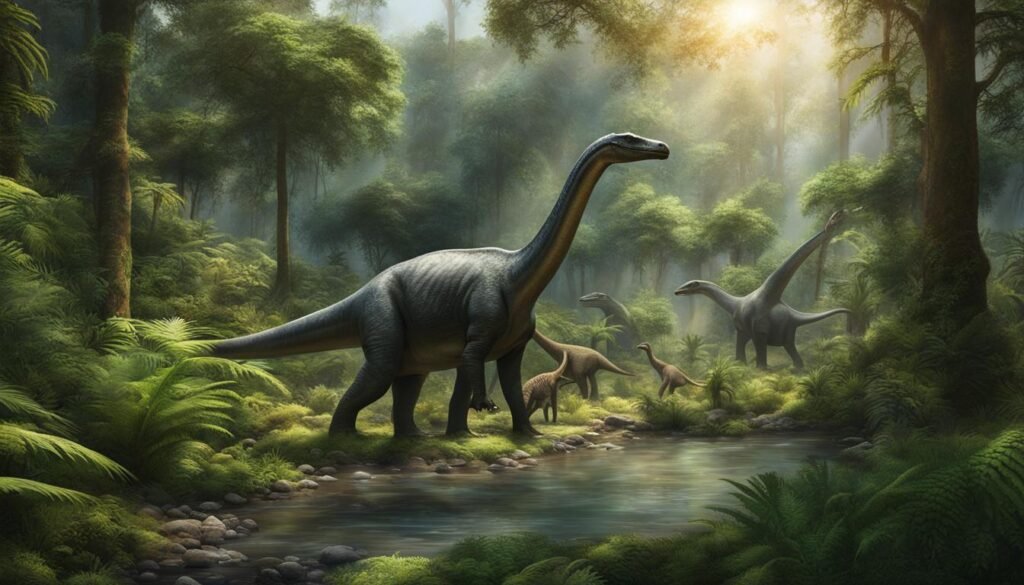
Dinosaur Migration: Key Takeaways
- Sauropodomorphs, massive herbivorous dinosaurs, migrated during the Late Triassic period.
- Fluctuations in carbon dioxide levels played a role in their migration patterns.
- A drop in carbon dioxide levels made it easier for dinosaurs to migrate.
- Greenland provided a suitable habitat for sauropodomorphs during this period.
- The study highlights the complex interplay between climate and dinosaur migration.
“The migration of sauropodomorphs from South America to Greenland during the Late Triassic period demonstrates the influence of carbon dioxide levels on dinosaur movement. This research provides valuable insights into the role of climate change in shaping the distribution and migration patterns of prehistoric creatures.”
Climate Change as a Catalyst for Fossilization in Different Environments
The impact of climate change on fossilization extends beyond terrestrial environments to include marine deposits as well. A recent study focusing on exceptional fossils from the Early Jurassic period reveals that climate change events played a significant role in the preservation of these remarkable specimens. By examining various lithologies and depositional settings, researchers found a connection between rapid climate changes and the availability of phosphorus-rich sediment, creating favorable conditions for exceptional fossil preservation. This highlights the influence of global climate events on the fossilization process, regardless of location or environment.
One key finding of the study is the effect of extreme and rapid climate changes on the availability of suitable sediment for fossilization. During the Early Jurassic period, an influx of greenhouse gases led to dramatic climate fluctuations, impacting depositional settings worldwide. The resulting changes in sea levels and oceanic currents affected the distribution of sediment, including phosphorus-rich layers. These sediments, which are crucial for the preservation of soft tissues and delicate structures, created ideal conditions for the exceptional fossilization observed in marine deposits from this period.
To illustrate the variations in exceptional fossil preservation across different environments, a comparative analysis of lithologies and depositional settings was conducted. The table below provides an overview of the different environments and their associated depositional characteristics, highlighting the diverse ways in which climate change influenced fossilization in each setting.
| Environment | Depositional Characteristics |
|---|---|
| Terrestrial | Fluvial deposits with intermittent flooding, leading to variable preservation conditions. |
| Marine | Phosphorus-rich sediments in nearshore environments, promoting exceptional fossil preservation. |
| Lacustrine | Sediments with low oxygen levels and slow depositional rates, enhancing preservation potential. |
“The study’s findings shed light on the diverse ways in which climate change can impact fossilization. From the creation of favorable sedimentary environments to the preservation of delicate soft tissues, understanding these processes is crucial for unraveling the mysteries of Earth’s ancient ecosystems.”
The exceptional fossils preserved in different environments provide valuable insights into the effects of climate change on the fossilization process. By studying the interplay between climate fluctuations and the availability of suitable sediment, researchers can gain a deeper understanding of the factors influencing exceptional fossil preservation. This knowledge is essential for reconstructing ancient ecosystems and for assessing the potential impact of ongoing climate change on Earth’s biodiversity.
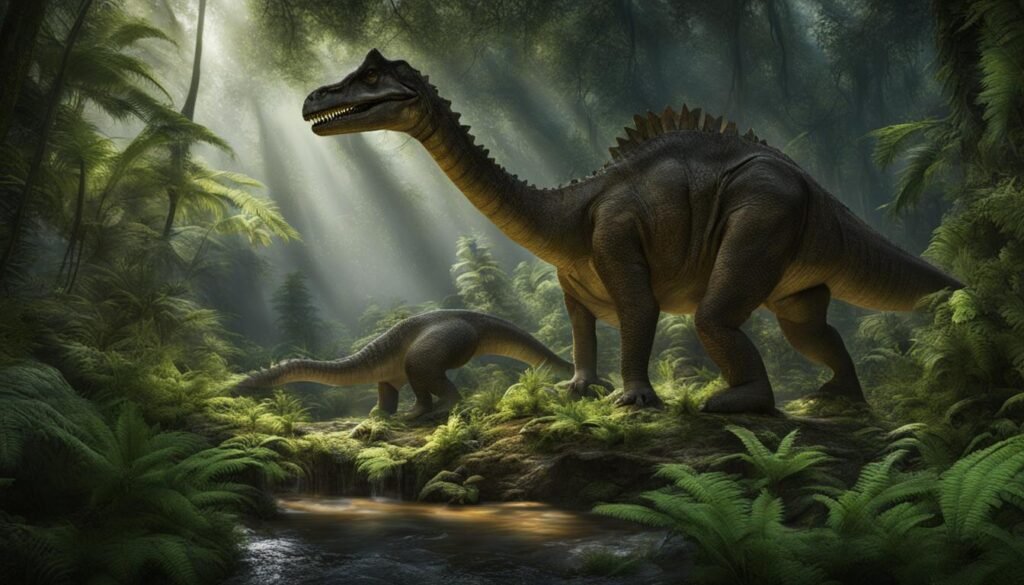
Evidence of Dinosaur Migration and Settlement in Greenland
Greenland, a land of ice and snow, may seem like an unlikely place for dinosaur fossils and footprints. However, recent discoveries have revealed an abundance of sauropod fossils in this icy terrain, shedding light on the migration and settlement patterns of these long-necked dinosaurs. The presence of these fossils suggests that the climate and environmental conditions in Greenland were once conducive for the survival of these magnificent creatures.
Researchers have uncovered fossilized footprints in tropical and arid regions, indicating that sauropods, such as the massive Apatosaurus and Diplodocus, may have migrated through Greenland during their journeys. These footprints provide valuable insights into the behavior and movement patterns of these ancient animals. The discovery of sauropod fossils in Greenland also aligns with the findings of a study that suggested lower carbon dioxide levels facilitated dinosaur migration during the Late Triassic period.
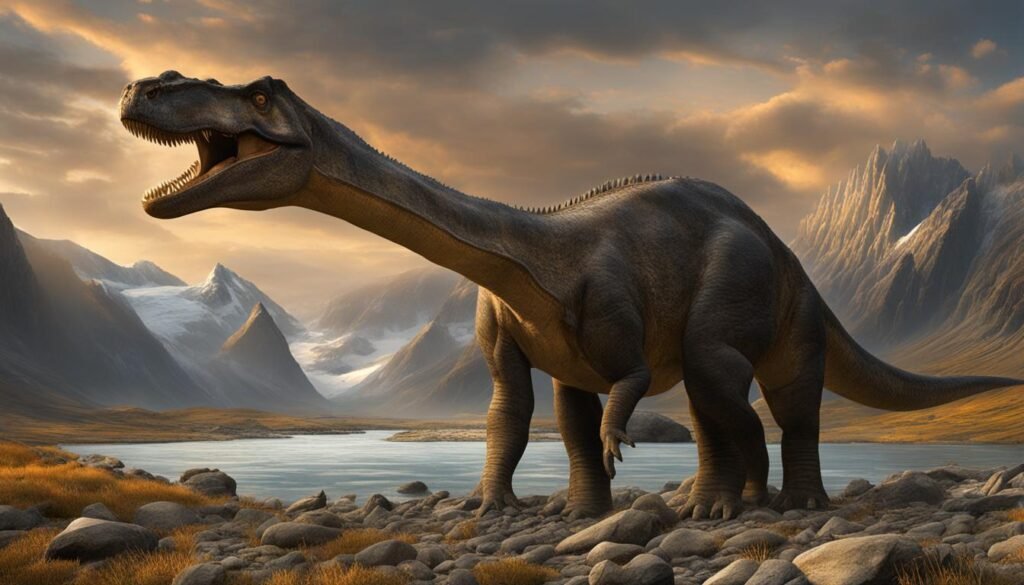
“The migration of sauropodomorphs to Greenland occurred during a time when carbon dioxide levels were halved, making conditions more favorable for migration.”
The climate conditions in Greenland would have played a crucial role in the survival and migration of sauropods. As carbon dioxide levels dropped, the climate became cooler and more suitable for these large herbivorous dinosaurs. This natural shift in climate likely influenced their movement patterns and allowed them to venture into new territories, including Greenland.
The Significance of Greenland’s Fossil Record
The presence of sauropod fossils and footprints in Greenland offers a unique perspective on dinosaur migration and settlement. It expands our understanding of how these ancient creatures adapted to changing climates and environments. The discovery also highlights the importance of considering unconventional locations when studying dinosaur fossils, as they can provide unexpected insights into the behavior and distribution of these prehistoric giants.
Furthermore, studying the climate conditions that supported dinosaur migration in Greenland can provide valuable information for paleoclimate reconstructions. The evidence of lower carbon dioxide levels and favorable climate conditions in Greenland during the Late Triassic period adds to our understanding of past environmental dynamics and their influence on Earth’s ecosystems.
| Key Findings | Implications |
|---|---|
| Sauropod fossils and footprints discovered in Greenland | Suggests the presence of suitable climate and environmental conditions in Greenland for dinosaur migration and settlement |
| Lower carbon dioxide levels during the Late Triassic period | Likely facilitated dinosaur migration, including the movement of sauropods to Greenland |
| Unconventional locations can provide unexpected insights into dinosaur behavior and distribution | Expands our understanding of how dinosaurs adapted to changing climates and environments |
| Climate conditions in Greenland during the Late Triassic period can contribute to paleoclimate reconstructions | Provides insights into past environmental dynamics and their influence on Earth’s ecosystems |
Conclusion
The studies reviewed in this article provide compelling evidence for the significant impact of climate on dinosaur fossilization. The findings challenge the traditional view that the Chicxulub asteroid impact alone caused the extinction of non-avian dinosaurs. Instead, they suggest that climate change, in conjunction with other factors, played a pivotal role in shaping the fate of these ancient creatures.
Environmental conditions, such as sediment availability and temperature fluctuations, greatly influenced the preservation of dinosaur fossils. The variation in fossilization rates between different regions, as observed in North America, highlights the importance of local climate conditions in determining the diversity and abundance of dinosaur species.
Furthermore, the link between climate and fossilization extends beyond terrestrial environments. The exceptional preservation of marine fossils from the past provides valuable insights into how climate change influenced the preservation of delicate marine animals and their soft tissues.
In conclusion, the interplay between climate and fossilization is an essential factor in understanding the history of our planet and the extinction of dinosaurs. By unraveling the intricate relationship between climate change effects, fossilization, and dinosaur extinction, we gain deeper insights into ancient ecosystems and underscore the urgent need for climate change mitigation efforts to safeguard Earth’s biodiversity.

